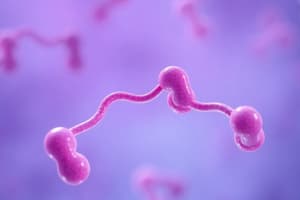Podcast
Questions and Answers
What is the general term for a big polypeptide with more than 50 amino acids?
What is the general term for a big polypeptide with more than 50 amino acids?
- Polypeptide
- Amino acid
- Peptide
- Protein (correct)
Which part of the amino acid is the side chain?
Which part of the amino acid is the side chain?
- R group (correct)
- NH group
- CH2OH group
- OH group
What is the result of cysteine oxidation?
What is the result of cysteine oxidation?
- A reversible peptide bond
- An irreversible covalent bond
- A hydrogen bond
- A reversible disulfide bond (correct)
What is the direction of biosynthesis in terms of peptide bond formation?
What is the direction of biosynthesis in terms of peptide bond formation?
What is the FDA's criteria for distinguishing proteins from peptides?
What is the FDA's criteria for distinguishing proteins from peptides?
What is the term for a polypeptide that is made entirely by chemical synthesis and is less than 100 amino acids in size?
What is the term for a polypeptide that is made entirely by chemical synthesis and is less than 100 amino acids in size?
What is the purpose of disulfide bonds in proteins?
What is the purpose of disulfide bonds in proteins?
What is the term for the nonstandard amino acid formed when two cysteine residues form a disulfide bond?
What is the term for the nonstandard amino acid formed when two cysteine residues form a disulfide bond?
What is the direction of chemical synthesis in terms of peptide bond formation?
What is the direction of chemical synthesis in terms of peptide bond formation?
What is the result of the oxidation of two cysteine molecules?
What is the result of the oxidation of two cysteine molecules?
Flashcards are hidden until you start studying
Study Notes
Biosynthesis of Ribosomal Peptides
- Ribosomal synthesis of peptides proceeds under genetic control from N-terminus to C-terminus using proteinogenic α-amino acids.
- The process involves transcription, translation, and protein synthesis in the nucleus and cytoplasm.
Importance of Peptides and Proteins
- Peptides and proteins play a central role in nearly all physiological processes of living cells.
- They present a remarkable range of biological properties and have crucial roles in physiological mechanisms.
Classification and Examples
- Hormones: chemical communication and coordination, secreted by neuroendocrine cells and released into the bloodstream to stimulate a response in another organ.
- Neuropeptides: hormones secreted and used in the central nervous system.
Amino Acids and Peptide Bond Formation
- Polypeptides are linear polymers of amino acids linked by peptide bonds.
- Amino acid residues are named by the number of amino acids.
- Peptide bond formation involves a dehydration reaction between the amino group of one amino acid and the carboxyl group of another.
Classification of Peptides
- Dipeptide: two amino acids combined.
- Tripeptide: three amino acids combined.
- Tetrapeptide: four amino acids combined.
- Oligopeptide: a few (4-10) amino acids combined.
- Polypeptide: 10-50 amino acids combined.
- Protein: a large polypeptide (> 50 amino acids).
FDA Regulation
- The FDA distinguishes between proteins and peptides based on size, with "chemically synthesized polypeptide" defined as an alpha-amino acid polymer that is less than 100 amino acids in size and made entirely by chemical synthesis.
Studying That Suits You
Use AI to generate personalized quizzes and flashcards to suit your learning preferences.




